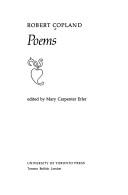| Listing 1 - 3 of 3 |
Sort by
|
Book
ISBN: 9781107039797 1107039797 9781139626576 9781316601938 9781107417281 1107417287 1139626574 9781107421103 1107421101 1316601935 1139893025 1107425115 1107422949 1107419905 1107418534 1299842232 9781139893022 9781107425118 9781107422940 9781107419902 9781107418530 Year: 2013 Publisher: Cambridge Cambridge University Press
Abstract | Keywords | Export | Availability | Bookmark
 Loading...
Loading...Choose an application
- Reference Manager
- EndNote
- RefWorks (Direct export to RefWorks)
In the years from 1534, when Henry VIII became head of the English church until the end of Mary Tudor's reign in 1558, the forms of English religious life evolved quickly and in complex ways. At the heart of these changes stood the country's professed religious men and women, whose institutional homes were closed between 1535 and 1540. Records of their reading and writing offer a remarkable view of these turbulent times. The responses to religious change of friars, anchorites, monks and nuns from London and the surrounding regions are shown through chronicles, devotional texts, and letters. What becomes apparent is the variety of positions that English religious men and women took up at the Reformation and the accommodations that they reached, both spiritual and practical. Of particular interest are the extraordinary letters of Margaret Vernon, head of four nunneries and personal friend of Thomas Cromwell.
Books and reading --- Christian literature, English --- Livres et lecture --- Littérature chrétienne anglaise --- History --- Sources --- Histoire --- Henry --- Mary --- England --- Angleterre --- Church history --- Histoire religieuse --- English Christian literature --- English literature --- Mary Tudor, --- Tudor, Mary, --- Maria --- Marie Tudor, --- Tudor, Marie, --- Henricus --- Heinrich --- Enrique --- Henri --- Hendrik --- Enrico --- Arts and Humanities --- Literature

ISBN: 1282039660 9786612039669 1442679425 9781442679429 0802057969 9780802057969 1487591233 148758959X Year: 1993 Publisher: Toronto
Abstract | Keywords | Export | Availability | Bookmark
 Loading...
Loading...Choose an application
- Reference Manager
- EndNote
- RefWorks (Direct export to RefWorks)
A lively pre-Renaissance world lives through the intricate and humane poetry of Robert Copland. His poetry includes a bequest of farts, a surprisingly psychologically complex satire on a bereaved widow, and the first poem of English life outside the law.
POETRY / European / English, Irish, Scottish, Welsh. --- Italy --- Antiquities, Roman. --- Copland, Robert. --- Copland, Robert, --- Critique et interpretation.
Book

ISBN: 0823285588 0823285596 9780823285587 9780823285594 9780823285570 082328557X 9780823285563 0823285561 Year: 2019 Publisher: New York, NY
Abstract | Keywords | Export | Availability | Bookmark
 Loading...
Loading...Choose an application
- Reference Manager
- EndNote
- RefWorks (Direct export to RefWorks)
Whose Middle Ages? is an interdisciplinary collection of short, accessible essays intended for the nonspecialist reader and ideal for teaching at an undergraduate level. Each of twenty-two essays takes up an area where digging for meaning in the medieval past has brought something distorted back into the present: in our popular entertainment; in our news, our politics, and our propaganda; and in subtler ways that inform how we think about our histories, our countries, and ourselves. Each author looks to a history that has refused to remain past and uses the tools of the academy to read and re-read familiar stories, objects, symbols, and myths.Whose Middle Ages? gives nonspecialists access to the richness of our historical knowledge while debunking damaging misconceptions about the medieval past. Myths about the medieval period are especially beloved among the globally resurgent far right, from crusading emblems on the shields borne by alt-right demonstrators to the on-screen image of a purely white European populace defended from actors of color by Internet trolls. This collection attacks these myths directly by insisting that readers encounter the relics of the Middle Ages on their own terms.Each essay uses its author’s academic research as a point of entry and takes care to explain how the author knows what she or he knows and what kinds of tools, bodies of evidence, and theoretical lenses allow scholars to write with certainty about elements of the past to a level of detail that might seem unattainable. By demystifying the methods of scholarly inquiry, Whose Middle Ages? serves as an antidote not only to the far right’s errors of fact and interpretation but also to its assault on scholarship and expertise as valid means for the acquisition of knowledge.
Civilization, Medieval. --- Civilization, Medieval --- Middle Ages. --- Influence. --- Europe. --- alt-right. --- crusades. --- globalism. --- medievalism. --- middle ages. --- nation-state. --- race. --- white supremacy.
| Listing 1 - 3 of 3 |
Sort by
|

 Search
Search Feedback
Feedback About UniCat
About UniCat  Help
Help News
News